Intel Xeon E Six-Core Review: E-2186G, E-2176G, E-2146G, and E-2136 Tested
by Ian Cutress on November 5, 2018 12:00 PM EST- Posted in
- CPUs
- Intel
- Xeon
- Enterprise CPUs
- Xeon E
CPU Performance: Rendering Tests
Rendering is often a key target for processor workloads, lending itself to a professional environment. It comes in different formats as well, from 3D rendering through rasterization, such as games, or by ray tracing, and invokes the ability of the software to manage meshes, textures, collisions, aliasing, physics (in animations), and discarding unnecessary work. Most renderers offer CPU code paths, while a few use GPUs and select environments use FPGAs or dedicated ASICs. For big studios however, CPUs are still the hardware of choice.
All of our benchmark results can also be found in our benchmark engine, Bench.
Corona 1.3: Performance Render
An advanced performance based renderer for software such as 3ds Max and Cinema 4D, the Corona benchmark renders a generated scene as a standard under its 1.3 software version. Normally the GUI implementation of the benchmark shows the scene being built, and allows the user to upload the result as a ‘time to complete’.
We got in contact with the developer who gave us a command line version of the benchmark that does a direct output of results. Rather than reporting time, we report the average number of rays per second across six runs, as the performance scaling of a result per unit time is typically visually easier to understand.
The Corona benchmark website can be found at https://corona-renderer.com/benchmark
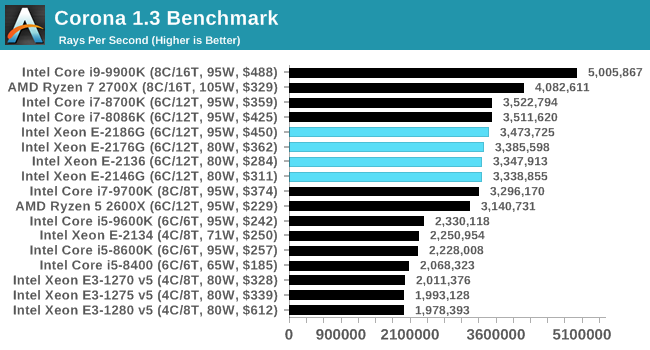
Blender 2.79b: 3D Creation Suite
A high profile rendering tool, Blender is open-source allowing for massive amounts of configurability, and is used by a number of high-profile animation studios worldwide. The organization recently released a Blender benchmark package, a couple of weeks after we had narrowed our Blender test for our new suite, however their test can take over an hour. For our results, we run one of the sub-tests in that suite through the command line - a standard ‘bmw27’ scene in CPU only mode, and measure the time to complete the render.
Blender can be downloaded at https://www.blender.org/download/

We had a small issue with Blender - after installing Intel IGP drivers, this version didn't want to work. We'll run through the tests that were affected when time permits.
LuxMark v3.1: LuxRender via Different Code Paths
As stated at the top, there are many different ways to process rendering data: CPU, GPU, Accelerator, and others. On top of that, there are many frameworks and APIs in which to program, depending on how the software will be used. LuxMark, a benchmark developed using the LuxRender engine, offers several different scenes and APIs.
Taken from the Linux Version of LuxMark
In our test, we run the simple ‘Ball’ scene on both the C++ and OpenCL code paths, but in CPU mode. This scene starts with a rough render and slowly improves the quality over two minutes, giving a final result in what is essentially an average ‘kilorays per second’.
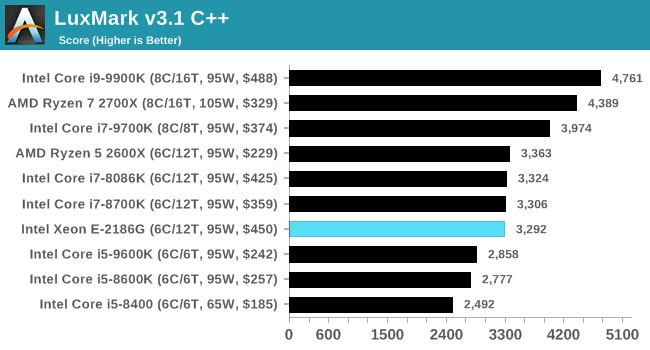
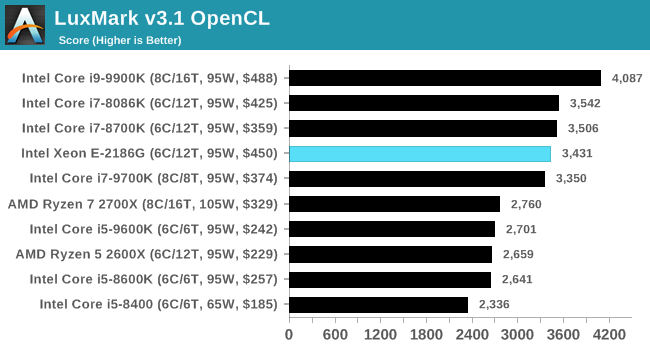
POV-Ray 3.7.1: Ray Tracing
The Persistence of Vision ray tracing engine is another well-known benchmarking tool, which was in a state of relative hibernation until AMD released its Zen processors, to which suddenly both Intel and AMD were submitting code to the main branch of the open source project. For our test, we use the built-in benchmark for all-cores, called from the command line.
POV-Ray can be downloaded from http://www.povray.org/
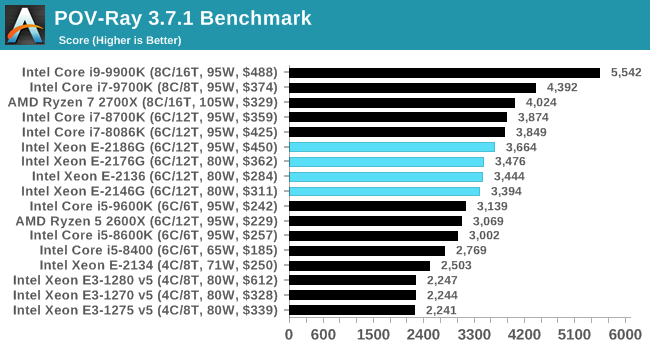



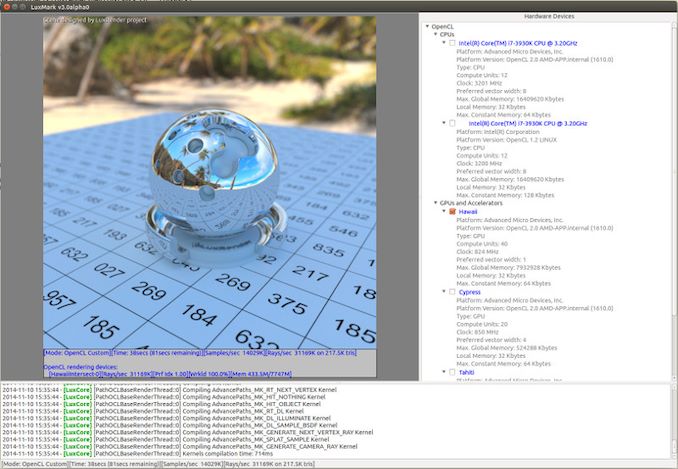








48 Comments
View All Comments
Jorgp2 - Monday, November 5, 2018 - link
Why don't you guys test iGPU encoding performance?speculatrix - Tuesday, November 6, 2018 - link
I agree, it would be useful to see video transcode performance, there's a few times when you want a media server with fast video transcode performance (i.e. real time 1080p60).Samus - Tuesday, November 6, 2018 - link
I'd also like to know where Quicksync performance lies on the new Xeons...mooninite - Wednesday, November 7, 2018 - link
Yes! I'd love to see iGPU encoding numbers, too. I would be buying one of these Xeons to get the encoding offloading you couldn't get with a Threadripper or EPYC.kuttan - Sunday, November 11, 2018 - link
For iGPU encoding you don't need a Xeon. For that any IGP based consumer desktop CPUs like Core i3/i5 or AMD Ryzen 2400G APU will do at a much cheaper price.mooninite - Tuesday, November 13, 2018 - link
@kuttan, you don't understand. I need a *server* system that has IPMI. i3/i5 or Ryzen systems don't provide IPMI. I also need a Micro ATX formfactor with 10GBASE-T NICs. Not going to happen on a i3/i5 or Ryzen system. Thanks though.Vidmo - Wednesday, November 7, 2018 - link
Agreed!shiznit - Wednesday, November 21, 2018 - link
no kidding... top 5 use case for these Xeons.just4U - Monday, November 5, 2018 - link
Thru-out the article I kept thinking.. Oh look a 6core product when 8core processors are becoming the norm at reasonable prices in desktop computers. In server settings I wonder why that would even be something to write home about.Ratman6161 - Monday, November 5, 2018 - link
Well, you really have to want/need that ECC RAM to make this worthwhile. Otherwise there is no point to going with an "E" over the equivalent desktop part.